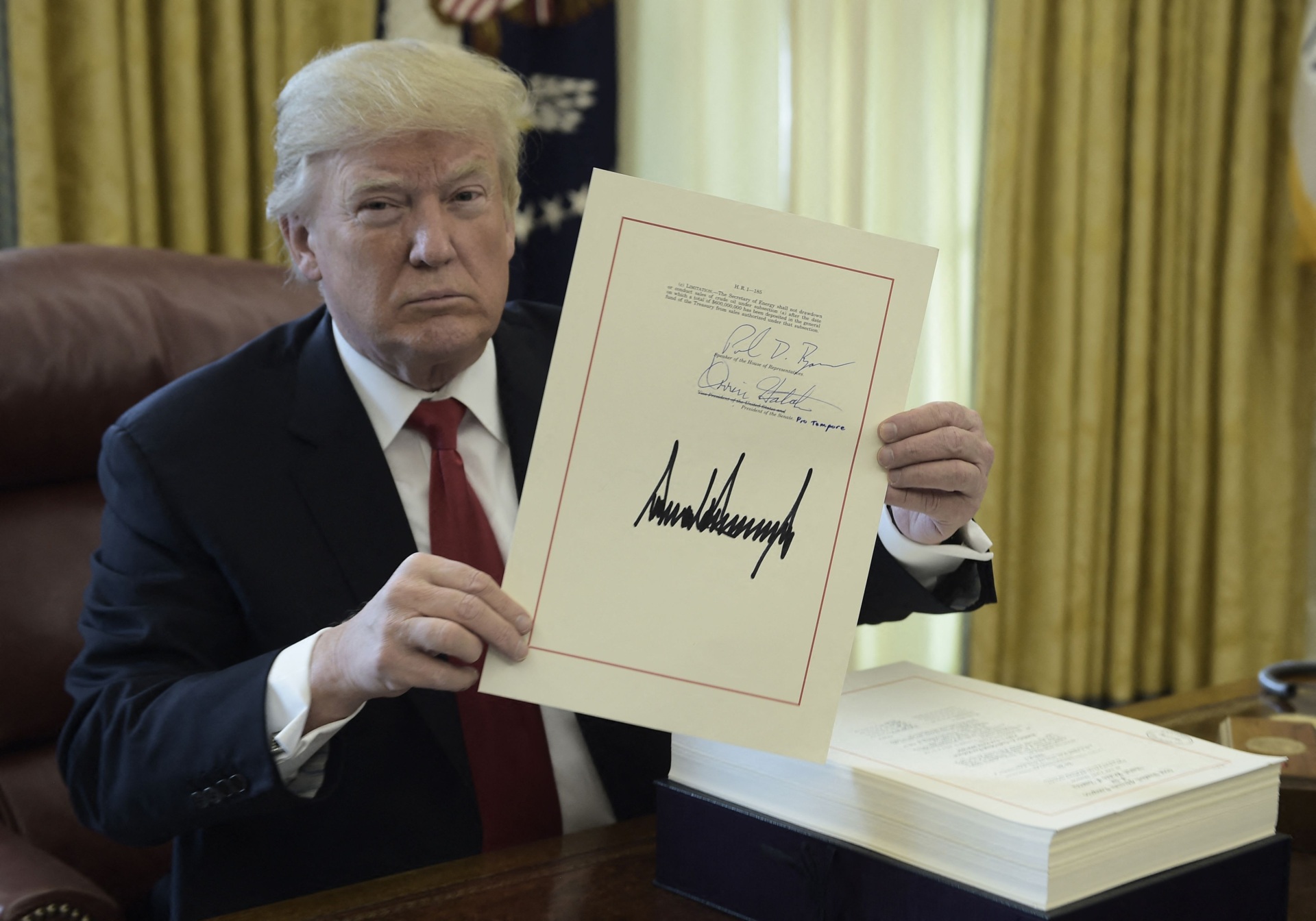Trump’s Tax Cuts Headed for a Fiscal Cliff
This year’s presidential and congressional elections are unlikely to be decided on the issue of tax policy, but they will very likely determine how much of the tax cuts enacted under President Donald Trump survive.
Many provisions of the 2017 Tax Cuts and Jobs Act are scheduled to expire at the end of 2025, an event economists are describing as a “fiscal cliff.” If Congress does nothing or the president stymies congressional action, the law will automatically impose tax increases on millions of Americans. Tax rates will rise, the standard deduction will fall, and child tax credits will shrivel.

President Donald Trump holds the Tax Cut and Reform Bill he signed into law in the Oval Office on December 22, 2017. (BRENDAN SMIALOWSKI/AFP via Getty Images)
The Trump tax cut law sunsetted most of the individual tax cuts for the usual budget shenanigan reasons. The way the official government calculations work, if a spending or tax cut provision expires in a few years, it has a smaller impact on the long-term budget estimates. So, even when a tax cut is expected to be extended or a spending program will likely last forever, the budgeting rules say the government accountants should pretend they will go away on their official expiration date.
If Trump wins back control of the White House, it is very likely that the Republicans will attempt to extend all of the individual tax cuts included in the 2017 law. A big victory for Republicans in November could even result in additional tax cuts, perhaps in the form of an expanded child tax credit.
A Biden victory will see many of them allowed to expire, resulting in tax hikes for many Americans. Some might be allowed to survive if Biden sticks to his promise to not raise taxes on Americans earning under $400,000 a year. That’s a very uncertain proposition, however, because a re-elected Biden will face a lot of pressure from his own party to break his tax pledge and raise taxes on middle class Americans to fund leftwing spending programs. And since Biden will come into office as a lame duck, the political necessity of resisting his party’s leftwing will be greatly diminished.
The Third Choice Is Even Worse
To a certain set of policy wonks, academics, and left-of-center tax specialists, the looming “fiscal cliff” is seen as an opportunity to “improve the tax code” with a much broader range of changes. The foremost proposal making its way around Washington was put forth by Kimberly A. Clausing of the UCLA School of Law and Natasha Sarin of Yale School of Law and Yale School of Management. Although it is pitched as a non-partisan set of reforms, it has a decidedly leftist bent.
“The Clausing-Sarin option uses the 2025 TCJA expiration as the jumping off point for a tax reform plan that aims to reduce the deficit, increase the progressivity of the tax code, limit existing avenues for tax avoidance, and address global issues like climate change,” according to a summary offered up by the Budget Lab, a newly launched outfit operating out of Yale University.
The Clausing-Sarin option includes a big tax increase on capital gains and dividends. It raises taxes on families that seek to pass on savings and assets from one generation to another. It imposes a carbon-fee on businesses and a financial transaction tax. It ramps up funding for IRS tax cops. Under the guise of expanding child tax credits, it would enlarge government handouts to low-income families even while it re-imposes higher tax rates on many taxpaying families. The corporate tax rate would be yanked up to 28 percent from the current 21 percent.
Growth in the Balance
The Budget Lab at Yale this week published its analysis of the economic effects of a full extension of the Trump tax cuts, a partial extension that might be enacted if Biden kept his tax promise, the Clausing-Sarin proposal, and the budgetary “baseline” in which the tax cuts are allowed to expire.
It will not be a surprise that the full extension of the tax cuts leads to much faster growth in the near term. The Budget Lab estimates growth accelerating from a 1.8 percent pace at the end of 2025 to reach a 2.15 percent annual rate in the third quarter of 2026 if all the tax cuts are extended. The partial extension sees growth accelerating to 2.09 percent. Under the no-extension baseline scenario, the economy grows at a 1.92 percent pace in the third quarter of 2026.
The Clausing-Sarin proposal actually slows growth down to 1.65 percent by the fourth quarter of 2026. That seems like a budget disaster. But don’t worry, the Budget Lab assures us. Actually, according to their model, the Clausing-Sarin is better over the longterm. That’s because the Lab figures that the pro-growth effects of the full-extension and partial-extension run out after five years, and by that time the economy is actually growing faster under the Clausing-Sarin proposal. If we would just endure half a decade of slower growth, we can have faster growth over the longer run.
How much faster growth? Not much as it turns out. The Budget Lab model has the long-run pace of growth under the Clausing-Sarin model at 1.83 percent and the pace under the full extension (which it sees as the worst for growth over the long run) at 1.79 percent. All those individual tax hikes, corporate tax hikes, carbon taxes, and investment tax hikes deliver less than five basis points of additional growth a year.
Why does the Budget Lab think the Clausing-Sarin model even does that much for growth? It figures that the additional taxes will decrease the budget deficit. The model then assumes that the decrease in the deficit results in lower interest rates. Those lower interest rates result in more business investment. The increase in business investment is seen as boosting growth.
The trouble is that the evidence that long-term interest rates are determined by budget deficits is very weak. The economic literature on the subject divides about evenly between those who find long-term interest rates rise because of budget deficits and those that find they do not. In our view, the best work agrees with what economists Robert Barro wrote in his 1987 textbook Macroeconomics that the belief that budget deficits push up interest rates “does not have evidence to support it.”
Long-term interest rates are largely determined by the expected return on capital and expectations about the path of short-term interest rates. That path of short-term rates, in turn, is determined by Fed policy. Monetary policy reacts to labor market conditions and inflation. What this means is that the level of the deficit matters a lot less than the spending and tax policies that create the deficit. Balancing the budget by taxing savings, for example, probably works in the opposite direction The Budget Lab assumes because it diminishes investment but does nothing to cut consumption.
Once you get rid of the imaginary deficit-to-interest rate mechanic, the trade-off between short-term growth and long-term growth vanishes. Which means that the full extension of the Trump tax cuts is the clearly preferable choice.
Tax policy, however, is typically the result of politics rather than economic prudence. So, what happens in November will be more important than whose model of interest rates and budget deficits is correct.

COMMENTS
Please let us know if you're having issues with commenting.